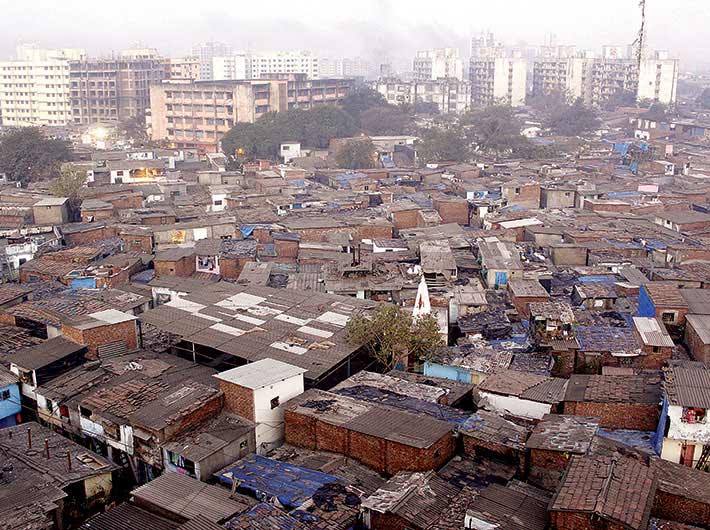Plans to redevelop one of the largest slums in the world faces resistance from a unique quarter – from its residents
The Maharashtra housing and development authority (MHADA) recently released a Dharavi redevelopment plan. The government expected constructive support from the residents of Dharavi, but they are upset. Corner meetings have been held, rallies organised and as a measure of final showdown Dharavi witnessed a total bandh on April 9 and more such agitations are being planned. An organisation called the Dharavi Bachao Andolan (DBA) has asked residents to hoist black flags atop their houses from June 15.
This is not new. Every time a fresh plan has been envisaged, Dharavi residents have risen in protest. It is indeed intriguing that Dharavi people oppose plans which are ostensibly meant to provide a better future to them. A historical analysis of growth of Dharavi and failed revamp attempts since 1987 reveal issues which if considered might help the process.
Dharavi’s history dates back to the late 1800s, when Kumbhars from Saurashtra settled there. Most land in Dharavi till around the mid-1900s was marshy and used as a dumping ground. This land was freely available and encroachments were not regulated. This helped people looking for shelter to encroach and build hutments. Residents recount stories of how they had to wade through knee-deep slush to reach their homes. With regular use, this damp marshy land developed into a cluster of hutments with narrow and winding lanes. Earlier no one bothered about these encroachments. Now the government is proactively trying to develop Dharavi. Citizens are opposed to this. Over the years, they feel they have become owners of the land and the government cannot take any unilateral decision regarding their settlement.
One of the first efforts to provide built-up houses in place of hutments was initiated through the prime minister grant project (PMGP) in 1987. Rajiv Gandhi sanctioned '100 crore for the project. It was shelved once the initial grant was over. In 1995 a slum rehabilitation scheme under the slum rehabilitation authority (SRA) was initiated. This proved to be a boon for private builders as the transferred development rights (TDR) could be used outside Dharvai. Constructions of buildings took place under SRA. The development here was, however, haphazard as most buildings came up close to the roads and none of the interior areas was developed.
Two surveys were carried out between 2004 and 2009 aiming at a more comprehensive development. M/s Prashant Survey was selected in 2004 to do a table survey of Dharavi. The firm never met the deadline. It faced opposition from local groups right from the start of the work. Acceding to the demands of local residents, the government appointed the Maharashtra social housing and action league (‘Mashal’) to do a biometric and socio-economic baseline survey (BSES) of Dharavi in 2007. Its mandate was to identify ground-floor structures which existed on or before January 1, 2000. Mashal as per the draft planning document published by MHADA distributed 22,130 ID cards to the structures from among 33,500 structures it found to be eligible till 2009.
This selective identification is the main problem. This is much too less as compared to unofficial estimates of around 1,50,000 tenements, which exist as of today in Dharavi. Besides this, there were a few localities, which did not cooperate in the survey. Kumbharwada residents refused to accept redevelopment as they claim to be owners of the land they reside on. They intend to get the area developed under SRA using private builders. Koliwada residents, on the other hand, refuse to agree on the boundary of Koliwada as per the published maps.
Against this backdrop, the latest development plan has surprisingly relied on data collected during these surveys. As these surveys were not completed, they do not reflect the complete picture of Dharavi. This plan only refers to 99 hectares of land, whereas Dharavi today has approximately 241 hectares of which around 17% is private land. The current plan addresses only a small segment of the Dharavi population and covers only around 41% of the Dharavi land.
Dharavi residents have other serious concerns too. One of the most vocal objections to the proposed plan is the fact that they were not consulted at all in formulating the plan. Their argument is that all these years when they lived in muck and slush, nobody bothered about them. Now since, the Bandra Kurla Complex has made Dharavi realty a goldmine, the government is trying all possible means to evict them and use the land for commercial purposes.
Another issue, which concerns the Dharavi residents, is that the surveys done so far have overlooked the fact that in one tenement four to five families are staying at times. In recognising only ground-level structures, those living on first or mezzanine floors have been excluded. Naturally, they are demanding eligibility for people who stay in various floors of the same structure.
Solutions to these issues are not easy. However, one thing is clear, that any development plan or survey has to include local residents as active participants. They currently feel sidelined. While the government may have a point that it owns as much as 61% of the Dharavi land, the fact that this land has been used by the Dharavi residents for years with little or no government intervention cannot be ignored. It is going to be near impossible if this right of use is overlooked. Since this fact has not been considered, no plan has moved beyond paperwork. SRA, in which some private entities were main beneficiaries, was the only exception. But SRA never addressed development needs of Dharavi in a comprehensive manner.
It is still not too late to constitute ward committees of residents who can be included in a consultative process from initial stages of development. As long as possible, residents should be allowed to decide how they need to develop places they currently inhabit. These ward committees can do the surveys under mutually acceptable terms and formulate plans, which can then be vetted by MHADA. Even in the bidding process for any construction work, societies made by local residents if they bid for development work, be given precedence over other private bidders. This will not only help the residents economically, but will also provide a sense of ownership to them.
Finally, any idea of using the existing land for sale to fund the project makes economic sense, but it is likely to face stiff resistance from residents and in all likelihood will get stalled. So for the time being, the plan has to focus only on rehab and renewal areas. Once rehab work is over, sale areas can be considered.
With each passing day clamour against the proposed plan is growing. If the current plans need to proceed, open dialogue with residents and their inclusion in formative stages is urgently needed to put a timely lid on agitations. With slight openness and an inclusive approach, Dharavi can become an ideal example of planned urban development in future.
Pandey worked in Dharavi as a police officer in during communal riots in the locality and has been associated with various NGOs working in it.

